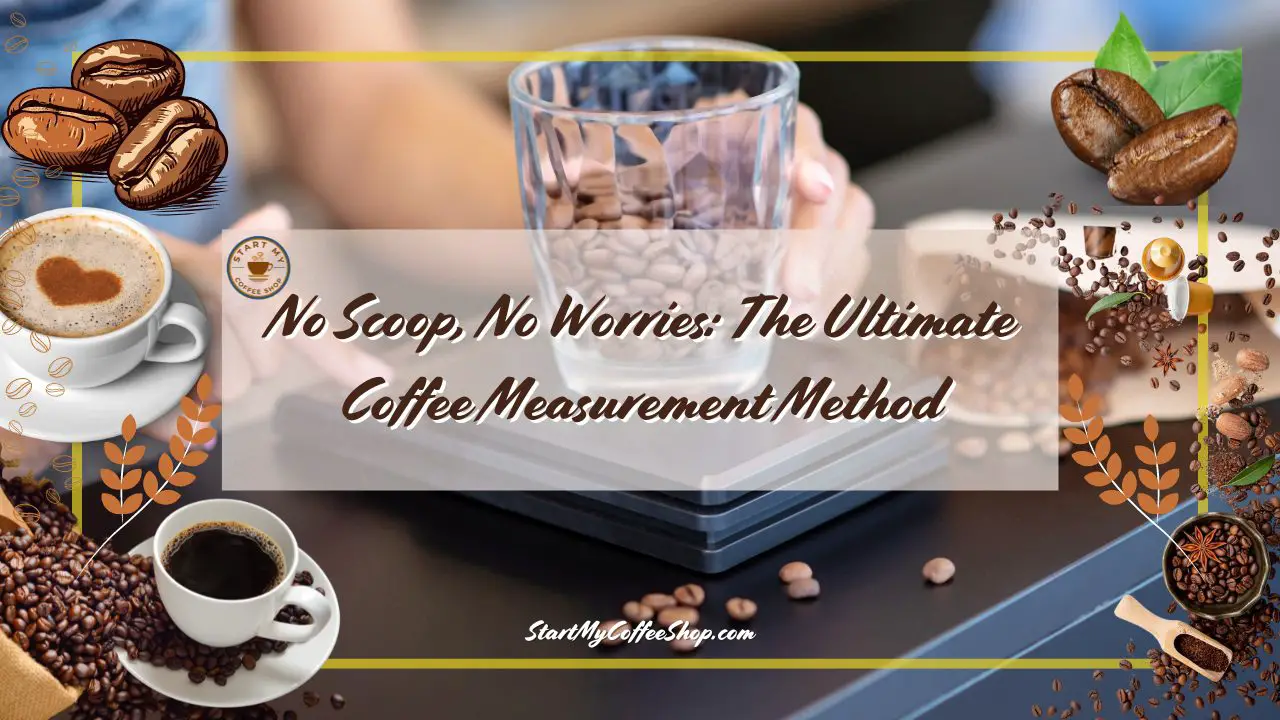The art of making the ideal cup of coffee is revered by coffee lovers. The creation of that delicious, aromatic elixir depends on each step in the brewing process. One of these components that is fundamentally important is accurate coffee measuring. Even though specialized scoops for coffee are frequently used for this, what if you don’t have one? There is a brilliant solution available, so do not be alarmed.
To precisely start with coffee measurement without a scoop, you should employ a tablespoon (15ml) as a makeshift scoop. For a standard cup, use 1 tbsp (7g) of coffee per 6oz water as your initial reference, adjusting it to your taste.
This article explores the world of measuring coffee without a teaspoon and reveals the keys to achieving accuracy and consistency. This exploration of coffee will reveal the techniques, tips, and adjustments necessary to create the ideal cup without a scoop.
The Role of Measurement in Coffee Brewing

Before we begin the voyage of measuring coffee without a scoop, it is critical to understand why exact measurement is so important in the coffee brewing process. Brewing coffee is a delicate balance of numerous critical factors, including water, coffee grounds, time, and temperature. Each of these components has an impact on the final taste and scent of the brew, making the process akin to an elaborate art form.
The precise measuring of coffee grounds is at the heart of this art. The appropriate amount of coffee and water combined to impact the intensity and flavor of the brew. Too much coffee in comparison to water can produce a bitter, overbearing cup that overwhelms the taste with powerful flavors. Using too little coffee, on the other hand, can result in a weak, disappointing brew, leaving coffee drinkers wishing for a more robust and gratifying experience.
Consistency and repeatability are qualities that any ardent coffee brewer seeks. Imagine enjoying a delicious cup of coffee one day, only to discover that your next try gives a very different result. Precise measurement serves as a guiding light in achieving consistency in your brews, helping you to replicate that ideal cup time after time.
For those who enjoy experimenting with different brewing techniques and processes, accurate coffee measurement serves as an important reference point. Understanding the exact ratio of coffee grinds to water that suits your taste preferences gives you the freedom to experiment with the brewing procedure. This knowledge allows you to experiment with new coffee beans, grind sizes, and brewing times while still preserving your preferred taste profile.
Read more about: Cold Brew Aesthetics: Exploring High-Quality Coffee Bean Varieties for Optimal Results
The Tablespoon as a Makeshift Coffee Scoop
There’s no need to fear if you don’t have a specialized coffee scoop, because the solution may be lying in your kitchen drawer. A tablespoon, a versatile utensil typically used in culinary endeavors, can function admirably as a makeshift coffee scoop. A regular tablespoon typically holds about 15ml of volume, making it a very constant amount for your coffee grounds.
Before you enter into the realm of scoop-free coffee measurement, you need to calibrate your tablespoon. While most tablespoons adhere to the 15ml standard, there might be minor differences in size, which can lead to errors in your coffee proportions. By calibrating your tablespoon, you can determine its exact capacity by using a kitchen scale. This simple but critical step guarantees that your measurements are precise and consistent with each use.
Calibration instills newfound confidence as you commence your coffee brewing adventure with the tablespoon as your trusted partner. Having this accurate measurement ensures that your cups of coffee keep a consistent degree of perfection, whether you’re a seasoned coffee connoisseur or a curious beginner. When it comes to measuring coffee grounds, the days of guessing and uncertainty are over.
The tablespoon’s utility extends beyond its capability for coffee measurement. Its presence in your kitchen drawer can inspire culinary discovery because it smoothly goes from making delectable cups of coffee to assisting with dishes that require precise ingredient quantities. A tablespoon is an indispensable tool in any kitchen, from baking to cooking.
The Ideal Starting Point for a Standard Cup
The exciting portion of determining your optimal starting point for a regular cup of coffee begins now that you’ve equipped yourself with the reliable and calibrated tablespoon as your improvised coffee scoop. While the world of coffee brewing is as different as the coffee beans themselves, we may start with a general rule of thumb: 1 tablespoon (7g) of coffee per 6 ounces (180 ml) of water.
This tried-and-true ratio achieves a delicate balance of strength and flavor, laying the framework for an exceptional coffee brewing experience. The 1:6 ratio guarantees that the coffee is neither overpowering nor diluted, resulting in a cup that both satisfies and uplifts your senses.
However, it’s important to remember that each coffee enthusiast is unique, and your particular preferences may lead you down different routes. Coffee’s beauty is in its adaptability, and as you explore the enormous variety of coffee beans, roast levels, grind sizes, and brewing methods, your taste preferences will surely alter.
Consider this first ratio a blank canvas to be tweaked according to your preferences as you begin your coffee brewing experience. Enjoy the chance to explore and fine-tune your coffee measures to make a cup that perfectly resonates with your taste senses. A modest increase in coffee grounds may be the answer for people who want a bolder and richer beverage. If you prefer a milder cup, altering the coffee-to-water ratio slightly may result in the perfect balance.
Several elements influence the overall flavor of your coffee. The roast level of the coffee beans—light, medium, or dark—can have a major impact on the flavors and fragrances generated throughout the brewing process. The grind size is also important, determining the extraction rate and, eventually, the flavor character of your coffee.
Take note of the nuances in flavor and scent that emerge with each brew, and embrace the thrill of exploration. Accept the path of discovery as you discover the small differences that can make or break your cup of coffee.
Adjusting to Perfection: Finding Your Sweet Spot

It’s time to put your abilities to the test and brew that ideal cup of coffee, armed with your calibrated tablespoon and the 1:6 coffee-to-water ratio. The actual beauty of utilizing a tablespoon as a coffee scoop is its easy adaptability, which allows you to make quick and accurate adjustments to your measures.
After you’ve brewed your coffee, take a moment to enjoy it. If you find the flavor too strong or the brew too bitter, don’t worry; the answer is as simple as adjusting the number of coffee grounds you use. You can tone out the strength by reducing the amount of coffee grounds slightly, resulting in a smoother and more balanced cup.
If your brew is a little weak or lacks the desired flavor profile, there’s a simple fix: add more coffee grounds. This change adds depth and character to your coffee, improving its flavor to perfectly match your preferences.
Remember that experimenting is the path to mastery in the pursuit of brewing perfection. Don’t be afraid to experiment with different quantities and ratios to suit your preferences. Everyone’s palate is different, and establishing your specific preferences is the first step toward coffee perfection.
Keep track of the changes you make during your brewing trials. This activity is useful for keeping track of your progress and seeing patterns in flavor profiles. Your record will gradually reveal the keys of your personalized coffee measurement—a formula suited especially to your preferences.
As you embark on your coffee-brewing adventure, embrace the delight of discovery. Each adjustment puts you closer to that elusive, magnificent cup that tantalizes your senses and delights you. You’re well on your way to being a coffee maestro, producing cups of liquid art that dazzle and captivate with every taste, with the tablespoon as your trusted guide and your adventurous spirit as your compass.
Read more about: Compact & Creative: Optimal Coffee Shop Kitchen Design for Limited Spaces
The Role of Grind Size
Using a tablespoon as a coffee scoop is certainly helpful in the measurement procedure, but don’t overlook the importance of the coffee bean’s grind size. The grind size is critical in influencing the flavors extracted throughout the brewing process and in obtaining the perfect cup.
To maximize the potential of your coffee beans, different brewing processes require different grind sizes. If you’re using a French press, for example, a coarser grind is strongly advised. The larger coffee grinds allow for a gentler extraction procedure, reducing the possibility of over-extraction and fine coffee particles in your cup. As a result, the brew is rich and flavorful, with no unpleasant sediment.
When working with an espresso machine, on the other hand, a finer grind is critical. High pressure is applied to the finely ground coffee, resulting in a quick extraction that produces the concentrated shot of espresso we all know and love. A fine grind enables the rapid extraction required to produce the trademark crema, that delectable layer of froth over the espresso.
It is vital to embrace the spirit of experimenting to properly master the art of coffee brewing. Don’t be afraid to experiment with different grind sizes and how they affect the flavor of your coffee. Consider how a coarser grind in a French press produces a more mellow and aromatic brew, but a finer grind in an espresso machine produces a more robust flavor profile.
Remember to calibrate your tablespoon measurements when you move into the area of grind testing. With a coarser grind, you may find that gradually increasing the amount of coffee grounds in your tablespoon results in a well-balanced cup. When utilizing a finer grind, however, a tiny reduction in the coffee grounds may be required to retain that ideal harmony. Reaching the optimal grind size and tablespoon measurement combination will bring out the complex tastes that make each cup a distinct and wonderful experience.
Beyond the Standard Cup: Scaling Up and Down
The application of a tablespoon as a coffee scoop stretches far beyond the confines of the typical cup. One of the method’s pleasant advantages is its smooth adaptation to varied serving sizes, which cater to the diverse needs and preferences of coffee drinkers.
Whether you’re hosting a gathering of guests or looking for a quiet moment of leisure with a single cup, the tablespoon approach easily rises to the occasion. Because of the simplicity of this method, you can use the same tried-and-true ratio—1 tablespoon of coffee per 6 ounces of water—across all serving sizes, providing consistent and reliable results.
Making a larger pot of coffee for a group of friends is a pleasurable and stress-free activity. With your calibrated tablespoon in hand, you can securely measure the exact amount of coffee grounds required for the right amount of water. The result? A pleasant and aromatic brew that will impress and satisfy your guests, further reinforcing your image as a coffee connoisseur.
The versatility of the tablespoon, on the other hand, is equally helpful while indulging in a peaceful moment of self-care or seeking a quick pick-me-up. Measuring out the right quantity of coffee for a single cup becomes second nature, turning those solitary coffee times into a treasured and customized experience.
The tablespoon method’s versatility also allows for intriguing experimentation. As you explore the world of different coffee beans, origins, and roast styles, the ability to keep a consistent coffee-to-water ratio across different serving sizes allows you to realize each bean’s full potential.
This strategy also makes catering to diverse interests among family and friends a snap. Some people enjoy a more powerful and intense cup of coffee, while others prefer a milder and smoother cup. You may customize each serving precisely to individual tastes by modifying the number of coffee grounds while keeping to the 1:6 ratio, guaranteeing everyone gets their perfect cup.
Frequently Asked Questions
Can I use any tablespoon as a substitute for a coffee scoop?
While most standard tablespoons hold about 15ml, there may be some differences in size across brands or types of tablespoons. Calibrate your tablespoon by measuring its exact capacity with a kitchen scale before using it as a coffee scoop to ensure correct measurements.
How do I alter the coffee measurement to suit my taste?
To alter the strength and flavor of your coffee, start with a regular cup and 1 tablespoon (about 7g) of coffee per 6 ounces (180 ml) of water. Reduce the amount of coffee grounds slightly if the brew is too strong. If the brew is too weak, increase the amount of coffee grounds. Continue experimenting and making minor tweaks until you discover your ideal flavor.
Can I apply the tablespoon method to various brewing methods?
Yes, the tablespoon method can be applied to a variety of brewing processes. Consider the grind size of your coffee beans in addition to altering the coffee measurement. To maximize flavor extraction, different brewing procedures necessitate different grind sizes. To obtain the best results for your preferred brewing technique, experiment with different grind sizes while keeping the ratio of 1 tablespoon of coffee per 6 ounces of water constant.
To learn more on how to start your own coffee shop, check out my startup documents here.
Disclaimer: The information provided by StartMyCoffeeShop.com (“The Site”) is for general informational purposes only. All information on the Site is provided in good faith. However, we make no representation or warranty of any kind, express or implied, regarding the accuracy, adequacy, validity, reliability, availability, or completeness of any information on the Site. Under no circumstance shall we have any liability to you for any loss or damage of any kind incurred as a result of the use of the Site or Reliance on any information provided on the Site. Your use of the Site and reliance on any information on the Site is solely at your own risk. This blog post is for educational purposes only and does not constitute legal advice. Please consult a legal expert to address your specific needs. Terms and Conditions. (https://startmycoffeeshop.com/terms-and-conditions/)

Hi! I’m Shawn Chun
My adventure in coffee began when I first launched my first coffee shop back in the early 2000s. I had to figure out so many things on my own and to make it worse within 2 years of opening two large corporate coffee chains moved in just blocks away from me!
As I saw smaller and even some larger coffee shops in the neighborhood slowly lose customers to these giant coffee chains and slowly close up shop, I knew that I had to start getting creative…or go out of business.
I (like you may be) knew the coffee industry well. I could make the best latte art around and the foam on my caps was the fluffiest you have ever seen. I even had the best state-of-the-art 2 group digital Nuova Simonelli machine money could buy. But I knew that these things alone would not be enough to lure customers away from the name brand established coffee shops.
Eventually, through lots of trial and error as well as perseverance and creativity I did find a way to not only survive but also thrive in the coffee/espresso industry even while those corporate coffee chains stayed put. During those years I learned to adapt and always faced new challenges. It was not always easy, however, in the end, I was the sole survivor independent coffee shop within a 10-mile radius of my location. Just two corporate coffee chains and I were left after that year. All told the corporate coffee chains took down over 15 small independent coffee shops and kiosks and I was the last one standing and thriving.
Along the years I meet others with the same passion for coffee and I quickly learned that it is not only “how good a barista is” that makes a coffee shop successful, but the business side of coffee as well.
Hence why I started this website you are on now. To provide the tools and resources for up and coming coffee shop owners to gain that vital insight and knowledge on how to start a coffee shop successfully.
Stick around, browse through my helpful blog and resources and enjoy your stay! With lots of LATTE LOVE!
Shawn






